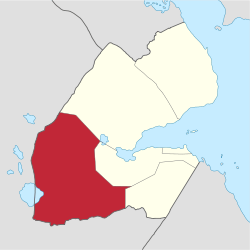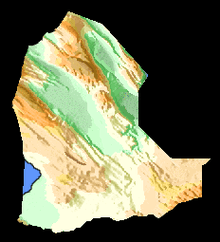Dikhil Region
| Dikhil Region | |
|---|---|
| Region | |
 | |
| Coordinates: 11°06′N 42°22′E / 11.100°N 42.367°ECoordinates: 11°06′N 42°22′E / 11.100°N 42.367°E | |
| Country |
|
| Capital | Dikhil |
| Area | |
| • Total | 7,200 km2 (2,800 sq mi) |
| Elevation | 1,362 m (4,469 ft) |
| Population (2010) | |
| • Total | 83,409 |
| • Density | 12/km2 (30/sq mi) |
| ISO 3166 code | DJ-DI |
The Dikhil Region (Somali: Gobolka Dikhil, Afar: Dikhil Rakaakay) is a region in southern Djibouti. It is bordered by the Regions of Tadjoura to the north, Arta to the northeast, Ali Sabieh to the east. To the west and south, it has a long line with the Djibouti-Ethiopia border adjacent to the Ethiopia Regions of Afar Region and Somali Region. Dikhil Region is the largest Region in Djibouti by area, with a mainland area of 7,200 square kilometres (2,800 sq mi), it is about the same size as Sikkim. The Dikhil Region's capital is the town of Dikhil.
History
During the Middle Ages, the Dikhil Region was ruled by the Ifat Sultanate and the Adal Sultanate. It later formed a part of the French Somaliland protectorate in the first half of the 20th century. While the region is built in "administrative position Gobad Dikkil" from March 25, 1927, it is only December 21, 1927 a detachment from Djibouti to recognize the region "and Dekkel Gobad" led by the Arthur Diderrich administrator. Following this mission, a military and administrative is installed at a place called Dikhil March 26, 1928. Become attached to a post "circle of Adaels" December 24, 1930, the district becomes a vicious self-April 9, 1931. It then includes all the southern colony, the Ethiopian border that French Somaliland. January 19, 1939 has created a "circle of Ali Sabieh" on the eastern part of the Dikhil. After several changes, this part definitely gets a separate entity in 1958 with the appointment of a specific administrator. Dikhil region takes the appearance it retains until the creation of the Arta region in 2002. On Asa Ragid site, the material found consists of shell middens from oysters, basalt rhyolite peaks whose dating for older, is at 5000–5800 years BC Also circular stone structures and a microlithic industry red jasper and obsidian and pottery shards more or less decorated beads and ostrich egg shell. As for the site of Asa Koma (Red Hill) As near Eyla, he revealed a life towards the end of the third millennium with a population of fishermen who hunted jackal, raised cattle and made pottery decorated with prints and chiseled features of good quality and which shapes and colors are similar to ceramics found in Sudan. It was discovered in 1989 a burial of an elderly adult and a young woman of 18. Many lithic obsidian and bone tools and beads of ostrich egg shells or shells of the Red Sea. Also animal bones, especially jackals, hippos rarely or gazelles, antelopes and domestic cattle and bones of fish (tilapia and catfish). Spread throughout the country and in more recent times are the cairn housing Graves (hundreds in the north). In one of these mounds in Balho, we found a fragment of cranium from the early first millennium BC The diversity of these burials attests different periods to which they relate.
Geography
Dikhil Region is in the west part of the Republic of Djibouti, the Region of Dikhil is the largest Region in the country, it accounts for 27.5% of the land of Djibouti. Dikhil Region is best known for its desert landscape. It is also known for its climate, which presents exceptionally hot summers and mild winters. The Region is made up of three geologic regions: Mountains, Plains-Valleys, and Desert which occur in large bands from west to east. Because of the different geologic regions there are contrasting climates and ecosystems. The precipitation and temperature in the mountainous areas depends on the elevation.
Climate

The climate in the Region depends mainly in the elevation of the terrain. The Dikhil Region has cold winters than the highlands, while the lowlands has mild winters. This climate zone has warm summers reaching a maximum temperature of 94°F and summer lows of 78°F. Winters are cold reaching a maximum low of 59°F and a maximum high of 76°. Climate in Ali Sabieh Region can be hot, although extended periods over 100 °F (38 °C) for the maximum temperature are rare, except for the lowest point in elevation. Hot summer days are tempered by the low relative humidity and cooler evenings during summer months since, for most of the state, the highest diurnal difference in temperature is often in the summer.
Northern Dikhil Region
Monthly normal high and low temperatures (°F) for various Northern Dikhil Region cities
| Town | Min. Temp | Max. Temp | Rainfall |
|---|---|---|---|
| Yoboki | 18.6 °C (65.5 °F) | 35.1 °C (95.2 °F) | 160 mm (6.3 in) |
| Galafi | 20.4 °C (68.7 °F) | 40.4 °C (104.7 °F) | 127 mm (5.0 in) |
During fall, winter, and spring, it experiences the most clear days statewide. The wettest months in this region occur during the summer. Winds are strengthened as they are forced to push through canyons and valleys.
Southern Dikhil Region
Monthly normal high and low temperatures (°F) for Southern Dikhil Region cities
| Town | Min. Temp | Max. Temp | Rainfall |
|---|---|---|---|
| Dikhil | 19.1 °C (66.4 °F) | 39.8 °C (103.6 °F) | 165 mm (6.5 in) |
| `As `Ela | 17.3 °C (63.1 °F) | 34.7 °C (94.5 °F) | 177 mm (7.0 in) |
The wettest months are the summer inland, where it is drier, ranches dominate the landscape, characterized by thick spiny brush and grasslands. Winter nights commonly see temperatures fall below 14 °F (57 °C)
Overview
According to the 2009 Census, the local population consists of 88,948 individuals, 41,552 of whom are nomads.
Towns
References
- "Djibouti". World Factbook. Central Intelligence Agency. 2007-09-06. Retrieved 2007-09-18.